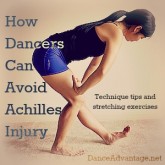 The Achilles tendon is an important and commonly injured part of a dancer’s body and in a previous post (linked to earlier in this sentence) we touched on why and how to prevent its injury. It’s no surprise you have more questions about how best to treat and avoid tendonopathies (tendon trouble) in the lower leg. The following continues with technique tips and stretching exercises that will help you do just that.
The Achilles tendon is an important and commonly injured part of a dancer’s body and in a previous post (linked to earlier in this sentence) we touched on why and how to prevent its injury. It’s no surprise you have more questions about how best to treat and avoid tendonopathies (tendon trouble) in the lower leg. The following continues with technique tips and stretching exercises that will help you do just that.
The balance between strength and flexibility:
Part of overall muscular fitness is recognizing that every athlete (and I’m including dancers here as athletes) must have a balance between muscular strength, muscular endurance, and flexibility. The ratio of each of these components changes based on the demands of the sport, and obviously most dance forms require a higher degree of flexibility than other athletic pursuits.
Dancers are ultra-aware of the importance of maintaining good flexibility, but the demands of today’s choreography also require a considerable amount of strength, endurance, and power. Too much emphasis on strength, and the dancer risks injury from tendons being too tight. Too much emphasis on stretching, and loosey-goosey tendons can easily become overstretched and at risk for injury.
Hands down, the best way to avoid lower leg tendon injuries is to be diligent about proper technique, particularly when performing jumping movements.
Jumping puts a lot of stress on the Achilles tendon, and most techniques require the dancer to press through the heels to cushion the landing. Every time a jump is landed, the dancer completes a soft, toe-ball-heel progression before pushing off into the next jump.
Aside from protecting the tendon from injury, this technique will also load the tendon and allow its natural elasticity to recoil and propel you into the next jump.
The Stress Reflex:
When a muscle is stretched, there is an automatic neural (brain) response that causes the stretched muscle to contract and the opposing muscle to relax.
As an example, a person standing on a bus that suddenly moves forward will experience a tightening of the calf muscles to help prevent falling. There is a chain of muscular contractions up the body through the quads, gluteals, hip flexors, and postural muscles as a result that are the body’s way of attempting to right the body against the force of the bus moving.
If this response is not fast or forceful enough to counterbalance the perturbation and upright the passenger, he or she will either take a step forward or fall. The contraction of the calf muscles is in response to the perturbation of the bus moving forward, rather than by voluntary control, and therefore it happens more quickly than voluntary initiation of movement. If the Achilles tendon is exceptionally tight, the jolting of the bus is more likely to raise the heels off the ground, forcing the passenger to take a step or fall.
Landing from a sauté in dance class is different, in that dancing is a voluntary movement. But the elastic nature of the tendons used in the stretch reflex also contributes to force production in a jump. When the dancer lands, he or she rolls through the foot, placing the heel on the floor. This stretches the Achilles tendon, initiating a stretch reflex that contracts the calf. The additional contraction from this reflex means that more force is available to give an increased height to the jump.
Long story short: Heels down, jump higher.
This isn’t always possible when, say, tempos increase, or if you dance in a technique such as Irish dancing or tap that calls for the heels to be continually off the ground. In these cases, you may not need that extra force, but remaining up off the heels for long periods of time places strain on the tendon. For these dancers in particular, it is even more important to balance strength with flexibility of the lower leg (side note: have you seen the calves of Irish step dancers? This only further proves my point that the technique lends itself to a disproportionate amount of strength of the calf muscles).
Stretching the lower leg:
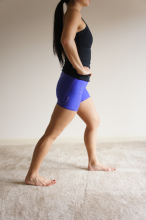
Tiffany of Dancing Branflakes pitched in for this post and created these beautiful photos of a stretch series to maintain good flexibility in the lower leg:
- Standing Calf Stretch: Place one foot behind your hip greater that the distance of your foot (fourth position parallel). Be sure to maintain a parallel position in both feet and bend the front knee until resistance is felt in the upper calf. Use a wall or barre for balance if needed. Hold for 30-60 seconds and repeat on the other side.
- Standing Soleus Stretch: In the same position as the standing calf stretch, or a slightly more narrow stance, bend the back leg instead of the front. The stretch will be felt further down the calf and into the Achilles tendon. Hold 30-60 seconds each side.
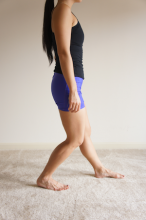
- Bend over hamstring stretch: From the souleus stretch, flex the front foot and bend at the hips to lean into the stretch. In addition to stretching the back lower leg, a hamstring stretch will be felt on the front leg. Hold 30-60 seconds each side. This stretch is pictured from the front and side view:
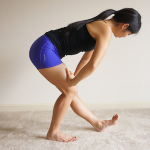
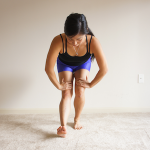
- Suspended calf stretch: Place the ball of the right foot on the edge of a stair, riser, or step stool (as pictured). Hold on for balance as neeede, and drop the right heel off the edge of the step for a deep calf stretch. Hold 30-60 seconds and repeat on the left.
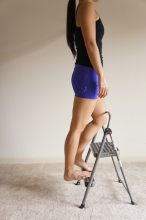
See more of Lauren’s research at the University of Illinois at Chicago on dance injuries and the return to work at www.artintercepts.org/research.
Lauren Warnecke is a freelance writer and editor, focused on dance and cultural criticism in Chicago and across the Midwest. Lauren is the dance critic for the Chicago Tribune, editor of See Chicago Dance, and founder/editor of Art Intercepts, with bylines in Chicago Magazine, Milwaukee Magazine, St. Louis Magazine and Dance Media publications, among others. Holding degrees in dance and kinesiology, Lauren is an instructor of dance and exercise science at Loyola University Chicago. Read Lauren’s posts.

